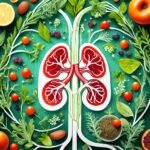I’ve found a natural way to help with ADHD symptoms that’s getting popular. Juicing for ADHD is a new way to help instead of traditional meds.
It gives you lots of nutrients to support your brain and help with ADHD issues.
Juicing uses fresh, organic fruits and veggies to give you lots of vitamins and minerals. These can make you more focused, less hyper, and help your brain work better. It’s like giving your body the right food to heal and do well.
Using natural ways like juicing is a kinder way to handle ADHD symptoms. Adding things like beets, leafy greens, berries, and ginger to your juices makes strong drinks. These drinks can help your brain stay healthy and might mean you need less medicine.
Drinking juices full of these good things can really help. I’ve seen that drinking them once or twice a day makes kids focus and behave better. It’s a simple and yummy way to make sure your kids get the good stuff they need to be healthy and sharp.
Key Takeaways
- Juicing offers a natural approach to managing ADHD symptoms
- Fresh, organic fruits and vegetables provide essential nutrients for brain health
- Regular juicing can improve focus, concentration, and overall cognitive function
- Specific ingredients like beets, berries, and leafy greens are particularly beneficial
- Serving detoxing juices 1-2 times daily can help reduce ADHD symptoms
- Juicing may potentially reduce the need for traditional ADHD medications over time
Understanding ADHD and the Role of Nutrition
ADHD affects many children and adults. In 2016, 6.1 million American kids got diagnosed with ADHD, up 43% from 2003. We’ll look at how diet affects ADHD symptoms and health.
What is ADHD?
ADHD means you might have trouble focusing, be too active, or act on impulse. These issues can make everyday tasks hard. Many turn to supplements and juicing for help instead of medicine.
How diet impacts ADHD symptoms
What we eat affects ADHD. Eating too much sugar can make some kids less focused. Some kids might get hyper from artificial food stuffs. Eating whole foods is key to handling ADHD better.
The benefits of a nutrient-rich diet
Eating foods full of nutrients helps with ADHD. Omega-3s in fish can help kids with ADHD. Zinc, iron, magnesium, and B vitamins are also important for the brain. Juicing can be a good way to get these nutrients.
Choosing whole foods and juicing can help manage ADHD symptoms. But, always talk to doctors to make a full plan for ADHD.
The Power of Juicing for ADHD
Juicing for brain health can really help those with ADHD. In the US, 1 in 20 kids have ADHD. So, finding natural ways to handle symptoms is key. Juicing gives you a tasty way to get brain-boosting nutrients.
Choosing to juice for better focus is smart. It’s an easy way to get lots of vitamins and antioxidants. These help your brain work better. Drinking fresh juice can clear your mind and help you focus more.

Adding juicing to my daily routine has really helped. It’s not just about getting nutrients. Making juice can be calming and fun. It’s also a good way to eat more fruits and veggies easily.
Studies show eating well is good for ADHD. A study found eating foods full of omega-3s, fruits, veggies, and whole grains helps kids with ADHD. This shows how important our diet is.
If you’re new to juicing, start with a good juicer. Cold-press technology is great for keeping nutrients in. Juicing isn’t a cure, but it’s a strong tool for managing ADHD. It’s about finding what’s best for you and your brain health.
Key Nutrients and Ingredients for ADHD Support
Some nutrients are key to helping manage ADHD symptoms. Let’s look at the main ingredients for your juicing recipes and diet for ADHD.
Brain-boosting vitamins and minerals
When making juicing recipes for ADHD, focus on nutrients that help the brain. Iron and zinc supplements can make ADHD symptoms better in kid. Vitamin D, often low in kids with ADHD, can cut down on hyperactivity. Adding magnesium with vitamin D can greatly reduce ADHD symptom.
Antioxidants and their role in cognitive function
Antioxidants are great for brain health. I suggest adding a daily multivitamin with vitamin C and E to your diet for ADHD. These help protect brain cells and may ease ADHD symptoms. Omega-3 fatty acids are also key, helping increase dopamine levels and offering a special nutrition for ADHD.
Best fruits and vegetables for ADHD juicing
Choose these ADHD-friendly ingredients for your juicing:
- Berries: Full of antioxidants
- Leafy greens: High in iron and magnesium
- Beets: Boost blood flow to the brain
- Citrus fruits: Help the immune system and reduce stress
- Ginger: A natural stimulant for alertness and focus
There’s no one ADHD diet, but eating healthy foods can help. By adding these ingredients to your juicing, you’re taking a step towards managing ADHD naturally.
Juicing for ADHD: Getting Started
I’m excited to share how to start juicing for ADHD! First, let’s focus on organic produce to avoid pesticides. These are bad for ADHD. Start with fruits and veggies your child likes.
For a balanced juice, mix 1 part veggies with 3 parts fruit. This makes the taste better and keeps it healthy. Great choices include apples, pears, beets, oranges, and carrots. They’re yummy and full of good stuff for your brain.
Getting kids involved in juicing makes it fun. Let them pick the ingredients or press the juicer. This can make them like fruits and veggies more.
Drink fresh juice within 20 minutes for the most benefits. Don’t have more than 4-8 ounces a day. Add whole produce for fiber too. These tips will help make juicing for ADHD fun and good for your family.
Top 5 Juicing Recipes for ADHD Symptom Management
Juicing recipes for ADHD can really help manage symptoms. These drinks are full of nutrients and taste great. They help boost focus and support brain health. The CDC says adults should eat 1.5 to 2 cups of fruits and 2 to 3 cups of veggies a day.
Let’s look at five juicing recipes that help with ADHD symptoms. These recipes use ingredients that are good for the brain.
Brain-Boosting Blueberry Blend
This juice has blueberries, banana, and spinach. Blueberries are full of antioxidants that help your mood and brain work better. Spinach gives you iron, which fights tiredness and helps you pay attention.
Calm and Concentrate Carrot Combo
Carrots, apples, and ginger make a great juice for focus. Carrots give you beta-carotene, and apples give you energy. Ginger adds a zing and can help with feeling anxious.
Focus-Enhancing Beet Blend
Beetroot, apples, and turmeric make this juice strong. Beets help blood flow to your brain, making it work better. Turmeric has curcumin, which fights inflammation and is good for your brain.
Green Monster for Mental Clarity
This green juice has leafy greens, pear, and lemon. Leafy greens are full of magnesium, which helps with ADHD symptoms like not paying attention and being too active. Pear adds sweetness and fiber.
Tranquilizing Turmeric Tonic
Turmeric, orange, and carrot make a calming drink. Turmeric’s anti-inflammatory effects can reduce brain inflammation. Oranges give you vitamin C, which is good for your brain.
| Recipe | Key Ingredients | Main Benefits |
|---|---|---|
| Brain-Boosting Blueberry Blend | Blueberries, Banana, Spinach | Antioxidants, Iron |
| Calm and Concentrate Carrot Combo | Carrots, Apple, Ginger | Beta-carotene, Natural sugars |
| Focus-Enhancing Beet Blend | Beetroot, Apples, Turmeric | Improved blood flow, Anti-inflammatory |
| Green Monster for Mental Clarity | Leafy greens, Pear, Lemon | Magnesium, Fiber |
| Tranquilizing Turmeric Tonic | Turmeric, Orange, Carrot | Anti-inflammatory, Vitamin C |
While these juicing recipes are great for ADHD, remember to eat a balanced diet. Adding high protein breakfast shakes and smoothies full of nutrients can also help manage ADHD symptoms.
Tips for Making Juicing Fun and Engaging for Kids with ADHD
Making juicing fun for kids with ADHD can change their diet. Kids with ADHD often want lots of sugar because they don’t have enough dopamine. Let’s see how to make juicing a fun part of their diet.
Get your child to help with juicing. Let them choose fruits and veggies at the store. This way, they might be more open to trying new foods. It might take up to 15 times for a child to try a new food.
Make juicing a fun experiment. Mix different fruits and veggies to create cool flavors. Your child might find a new favorite! This is a great way to help them eat healthier.
For kids who don’t like to eat much, try serving juices in fun ways. Use fun-shaped ice cube trays to make juice popsicles. These can be a tasty way to get more nutrients during the day.
| Juicing Tips | Benefits |
|---|---|
| Let kids choose ingredients | Increases engagement |
| Create colorful juices | Visually appealing |
| Make juice popsicles | Fun and nutritious snack |
| Experiment with flavors | Encourages trying new foods |
Be patient with kids who have ADHD. Some might not like certain textures. Let them help in ways they’re okay with, like washing fruits or pressing juicer buttons. This can make juicing fun for everyone in the family.
Incorporating Juicing into Your ADHD Management Plan
Juicing can help with ADHD nutrition. Making it a daily habit helps improve focus. Let’s see how to add juicing to your ADHD plan.
Creating a juicing routine
Start with one juice a day, in the morning. It gives you a boost for the day. Try to have 1-2 juices a day, using different fruits and veggies for nutrients. A balanced diet is key for a healthy brain and ADHD.
Balancing juicing with other dietary strategies
Juicing is good, but don’t forget whole foods. A good diet for ADHD includes veggies, fruits, nuts, seeds, lean meats, fish, dairy, and grains. Mix juicing with whole foods for the best nutrition. Eating lots of fruits and veggies can help with ADHD symptoms.
Monitoring progress and adjusting recipes
Watch how different juices affect your ADHD. Keep a journal of your focus, energy, and health. Change your recipes if you see what works best. If you feel better with certain ingredients, use them more in your juices.
| Symptom | Beneficial Ingredients | Suggested Juice Combination |
|---|---|---|
| Inattention | Leafy greens, berries | Spinach-Blueberry Boost |
| Hyperactivity | Beets, apples | Beet-Apple Calmer |
| Low energy | Carrots, oranges | Carrot-Orange Energizer |
Juicing is part of managing ADHD. Add it to exercise and enough sleep for the best results. Kids with ADHD need 60 minutes of activity and 9-11 hours of sleep.
Choosing the Right Juicer for ADHD-Friendly Recipes
Choosing the right juicer is very important for making ADHD-friendly juices. The Nama J2 Juicer is great because it uses cold-press technology. This keeps more nutrients in, which is good for ADHD and brain health.
When picking a juicer, I think about how easy it is to use, how clean it is, and how loud it is. Kids with ADHD might not like loud sounds. There are many types of juicers, like centrifugal, masticating, and triturating, each with its own good points.
I mix 80% vegetables with 20% fruits in my juices to keep sugar levels down. This mix helps keep energy and focus steady. I like to use organic produce from local farmers’ markets. This way, I get quality produce and might save money.
Remember, juicing is a supplement to a healthy diet, not a main part of it. Fresh juices are full of vitamins, minerals, and plant chemicals. They are a great way to add nutrients to a plan for managing ADHD.
FAQ
What is ADHD?
ADHD is a disorder that affects how the brain works. It makes people feel too restless, act on impulse, and have trouble focusing.
How can diet impact ADHD symptoms?
What we eat affects ADHD symptoms. Eating foods that are good for the brain can help. This might mean you need less medicine.
What are the benefits of juicing for ADHD?
Juicing gives you lots of vitamins and antioxidants. These help your brain work better. Juices can make you more focused and less hyper.
What are the key nutrients and ingredients for ADHD support?
Foods high in magnesium, iron, and vitamin B6 help with ADHD. So do vitamin C-rich foods and antioxidants. Good foods include beets, leafy greens, berries, citrus fruits, and ginger.
How can I make juicing fun and engaging for kids with ADHD?
Let kids pick the ingredients and help make the juice. Try different flavors and colors. Make juice popsicles and think about what they like.
How should I incorporate juicing into an ADHD management plan?
Make juicing a regular part of your day. Drink 1-2 juices a day. Eat whole foods too. Watch how you feel and change your juice recipes if needed.
What juicer is recommended for ADHD-friendly recipes?
The Nama J2 Juicer is great for ADHD-friendly juices. It uses cold-press technology to keep nutrients in fruits and veggies.







